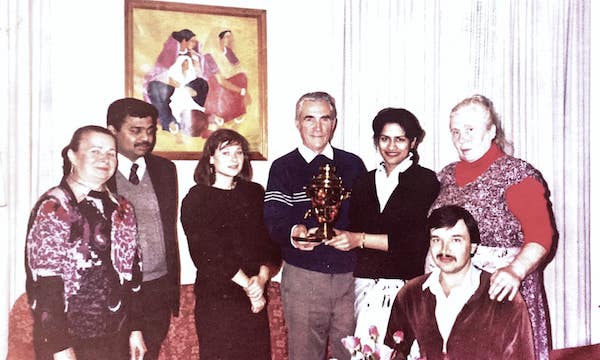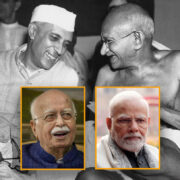The Odessa File: My Recollections of the Dawn of Ukraine’s Independence as a Young Indian Diplomat
- As I left this beautiful and complex country — with Catholic and Orthodox parts, speaking Ukrainian and Russian, but with delicious Ukrainian food — I could see that the challenge before the leadership was to build a national identity with regional interests addressed and harmonized.

I had arrived in the Soviet Union in September 1987 and spent almost a year learning Russian at Moscow State University. In late 1989, I was asked about my willingness to relocate to Odessa, a port city in Ukraine. I understood this suggestion to be a command. But I was not too unhappy with this instruction. Mikhail Gorbachev’s Perestroika and Glasnost were by now into their third year and had come to stay. My instincts told me that these were historical times and something big would happen. Here was a chance to be an eyewitness to history. These are some personal impressions of Ukraine of that era.
In December 1989, I reached Odessa. Impressions of that time may help capture Ukraine’s mood in those days. It was the largest district in Ukraine. Since it was a port town, it was common to see foreign sailors having a good time. Even within the framework, the local populace was relatively more relaxed about interacting with foreigners than Moscow. Incidentally, Odessa was the Soviet Union’s humor capital, even if some people saw it as a kind of crime capital, with talk of an Odessa mafia.
By this time, Soviet authorities had initiated limited economic reforms, which allowed small entrepreneurs to make their business moves, even if tentative. Odessa was famous for its vibrant ‘Primoz,’ where farmers sold produce from their private plots of land.
Chernobyl Cabernet
Ukraine was fresh from the Chernobyl accident, and that made me nervous. There was not much in the controlled media on the continuing aftereffects. Residents carried hand-held dosimeters, each costing around $15, which could detect radiation and used them on clothes and foods. Friends in this new location reassured me that there was an antidote to radiation — Cabernet from the local winery. It was said that Soviet authorities had instantly rushed wine consignments to the radiation-affected zone around the nuclear plant. There was no way to check and verify if this was true. Others dismissed such talk by saying that Soviet people needed any excuse to drink. Some enterprising locals carried around identity cards certifying that they had rendered service in the contaminated areas. This foldable red card helped them get priority to train and air bookings.
It was challenging to get precise figures for the local population, and some statistics indicated a stable population of around 450,000. In summers, this number swelled to almost 1 million as Soviet workers thronged sanatoria on the Black Sea coast, invoking their annual leave entitlements. The increase in the population by nearly a hundred percent was determined by monitoring the sales of bread loaves in summer versus winter.

It helped that I had commenced my diplomatic assignment as a reasonably fluent Russian speaker. There was no requirement to communicate through an overbearing and watchful interpreter. But there was the thought that it would help to learn Ukrainian additionally. It, therefore, came as a surprise that friends, including of Ukrainian stock, discouraged me when they discovered that I was learning Ukrainian. Perhaps, Ukrainians graduated to Russian as their first language over time. It seemed to be more like the case of Hindi spoken in Indian cities and on state TV versus the distinct regional dialects from the west to the east. Even then, I could see Ukrainian as a beautiful language closely connected to nature. For instance, October is ‘Zhovten,’ or the golden color (of vegetation), and November is ‘Listopad, describing the falling of leaves in autumn. Jumping ahead, Ukrainian seems to have come into its own after independence.
By the early 1990s, the centralized economy was crumbling, and the tight grip of the Communist Party of the Soviet Union on the country was loosening. All of this was visible in this Ukrainian trading and shipping hub too. As was typical, people carried bundles of Soviet roubles to buy essentials. It wasn’t easy to count all that, and I depended on the cashier to return the right amount of change.
In 1990, Ukrainian authorities introduced coupons that worked in conjunction with the Soviet rouble while purchasing goods. I recall, it was nothing but an A4 sheet with coupons printed on them in a table-like arrangement. There were no serial numbers on these coupons. The anxious staff of my office asked me how those working with foreign establishments could get coupons. I recall asking for one such sheet, and I put it in the photocopier. Out came an exact copy. The copies were tested in shops, and they worked. I guess everyone did the same, and not surprisingly, they disappeared or ended up as garbage.
‘Paying’ With Body Heat
In 1991, a quasi-currency, ‘Karbovanets,’ was circulated. This time, the notes looked and felt like the real currency. I understood that these notes had been printed in Germany. But again, like the coupon before, there were no serial numbers or signatures of a central banker. Over time, I learned that the genuineness of the notes could be established using one technique. When placed horizontally on the palms of hands, genuine notes would curl up to become bow-shaped. Body heat had something to do with this phenomenon. However, putting Karbovanets to such a test was cumbersome at shop counters.
Shopping was challenging. I was among the fortunate few to have access to shops meant for party leaders and foreigners. I picked up a fully automatic Soviet washing machine.
By word of mouth, one heard that new items had arrived. The advice was to dash to the store before they disappeared. I remember purchasing a light blue suit imported from Finland. To go with that, I also picked up a pair of East German Salamander shoes, and I proudly wore them for the May Day parade in 1990. To my horror, in the special VVIP box, I could see other colleagues wearing identical clothing! I promptly locked the suit into a trunk.
Western Ukrainians have a distinct identity, and I could see that they resisted the Russian language and cultural domination even in Soviet conditions. During a visit to Lviv, I struggled in broken Ukrainian because no one would respond to my Russian.
A little reference to the politics of that time is unavoidable. I recollect that Ukrainian President Leonid Kravchuk was inclined to sign the new Union Treaty, pushed by Gorbachev. His signature could have given a new lease of life to the Soviet Union, but Kravchuk feared nationalists from western Ukraine. The nationalists were organized around the Rukh party on the platform of independence. They were undoubtedly loud in what they did. They were more visible in western Ukraine bordering Poland. On the other hand, both Russian-dominated eastern and southern Ukraine, Odessa included, were apprehensive.
Western Ukrainians have a distinct identity, and I could see that they resisted the Russian language and cultural domination even in Soviet conditions. During a visit to Lviv, I struggled in broken Ukrainian because no one would respond to my Russian. They are primarily Catholic compared with the rest of Ukraine, where the Orthodox Church is dominant. And as far as history is concerned, the Lviv district, for instance, was carved out of Polish territory and made part of the Soviet Union around 1939-40. Therefore, a ten-year-old in Lviv in 1939 would have been in his 60s about the time of the breakup of the USSR with a decent memory of a time before the Soviets.
For various reasons, I found my visits to Kyiv becoming more and more frequent. While St. Petersburg has much to see, Kyiv is a charming city full of the history of the eastern Slavs. I enjoyed Ukrainian food — Borsch, Julien, and Cutlet-a La-Kyiv. Russian food internationally may well be Ukrainian. But I am not the last word on this.
War of Clocks
The people I interacted with in Odessa saw their future with Russia. If that was not possible, they might have wished for a special status independent of Ukraine as a self-governing territory. If I recollect correctly, in 1990, there was a war of clocks. Ukraine set a time different from Moscow in summer, and Odessa responded by putting its clock differently from Ukraine. When reporting for meetings, I had to check on each occasion whether my interlocutors were going by Russian time, Ukraine time, or Odessa time.
Odessa at that time had one of the largest Jewish settlements outside Israel. Many may have migrated by now. On visits to the bank, I had to push myself past Jews waiting to withdraw their deposits or convert their money into dollars as they prepared to leave. The locals followed the Gulf War in 1990-91 with keen interest.
About this time, a line of thought was emerging in Ukraine, which may be of interest. It was said that Ukraine had almost the exact population and territory as France, and it followed that Ukraine on its own had a fair chance of becoming another France.
There was no internet those days, and I greatly depended on gossip. In August 1991, I could see roads near my workplace undergoing repairs. I gathered that Soviet leader Gorbachev was traveling to neighboring Crimea and visiting Odessa from there. Like others in the city, when I switched on the TV in the morning of 19 August 1991, Tchaikovsky’s ‘Swan Lake’ and similar clips were being shown early in the morning of that fateful day. Changing channels did not make a difference. I realized that something big had happened.
When the coup took place against Gorbachev, several local communist leaders, including those in government positions, were understood to be celebrating and may have sent congratulatory messages to the coup leaders. As soon as the coup showed signs of failing, copies of such notes were removed from files and destroyed. Interestingly, close friends who had been interacting freely with me, most likely fearing that the Soviet security agencies were active again, sent in messages asking me not to call them for the time being. As the coup against Gorbachev collapsed, they were back as before. I would tease them for this.
Against that backdrop, President Kravchuk, on 24 August 1991, declared independence. Yeltsin’s lead role in defeating the coup leaders and TV images from Moscow of him standing on a tank plus Russia-first approach made it easier for Kravchuk in this process. Yeltsin’s victory was Russia’s victory, and there was no place for the other Republics.
As I was readying to leave for India in October 1992, I could see that the challenge before the leadership was to build a Ukrainian identity with regional interests and concerns adequately addressed and harmonized.
Gitesh Sarma retired from the Indian Foreign Service in 2021. A fluent Russian speaker, he served in Moscow and Odessa during 1987-92, covering Russia and Ukraine where he lived through the collapse of the Soviet Union. Has visited all the 15 countries which emerged after the disintegration of the USSR. In a career of almost 35 years, he spent many years in this region and working with these countries. He also worked in Belarus during 1998-99 and Uzbekistan during 2011-14. Sarma continues to follow developments in this region with keen interest, engaging with think tanks and media on strategic affairs, including this region. Additionally, he has done assignments in Hong Kong, Australia, Fiji Islands, Pakistan, and the United Kingdom.


